Archived Article Detail
By Thomas P. Moore
Need to search for a keyword, title or article on this page? On your keyboard, hold down the “Ctrl” and “F” key and a “Find in page” box will appear at the bottom of your screen. Type in your keyword and check the “Highlight All” box and like magic your keyword will appear highlighted as you scroll up and down the page!
WHAT’S NEW IN THE MINERAL WORLD ARCHIVE – posted on 1/18/2008
January 18, 2008
If the timing goes as expected, this installment of “what’s new” should be posted two weeks or so before the serious action at Tucson begins—the official opening day for Marty Zinn’s “Arizona Mineral & Fossil Show” is February 2. I hope that reading this quick survey might help to whet or, even better, inform your appetite if you are coming to Tucson, or that it might console you a bit if, unfortunately, you are not.
On The Web
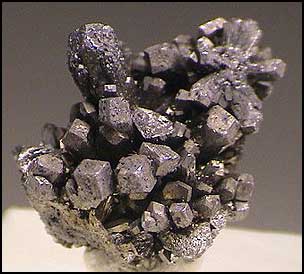
John Veevaert specimen and photo.
When my report on the 2007 Munich Show appears in the January-February 2008 issue (which is printed and about to go into the mail – along with a special “supplement”), an accompanying picture will show a remarkable spread of gratonite specimens from the type locality for the species, the Cerro de Pasco district, Alcides Carrión Province, Pasco Department, Peru. In the Mineralogical Record‘s “Peru Issue” (July-August 1997) you can read that the rare sulfosalt is found in groups of short-prismatic, metallic lead-gray crystals to 1.5 cm individually, on gray siliceous matrix (and that most of the best specimens are probably from the Excelsior mine in Cerro de Pasco). In Munich this past November, John Veevaert of Trinity Minerals latched onto about 25 small but excellent specimens of Peruvian gratonite: they had been picked up in Peru in the 1940’s by a German mining engineer, and his heirs finally were putting them on the market. You may see them now on John’s website (www.trinityminerals.com). As of January 10, nine of these very crisp little gratonite specimens had been sold and 14 were still “available,” and frankly this statistic surprises me, as the quality of the specimens (for their sizes) could hardly be better, and John’s prices are very civilized—in the high two or low three figures. The gratonite specimens range in size from 1 × 1 cm (for a loose, round cluster bristling all over with crystals) to 4.2 cm, for a matrix piece. In almost all cases the specimens show little to no damage, whereas most such gratonite clusters (in my experience at least) are pocked with unsightly metallic scars left behind where crystals have broken off at their bases. In short, John’s thumbnails and miniatures are super bargains in “old” specimens of what’s basically a one-locality species, in a selection unlikely to be equalled again.
In the 2007 Munich report I mentioned seeing some intriguing and just-emerging specimens of what’s apparently rutile/hematite pseudomorphic after ilmenite, brought to Munich by an Italian dealership which is now working some small specimen-prospects in Africa. The locality is a place in north-central Zambia called Mwinilunga, near the western end of the famous “copper belt” of the Democratic Republic of Congo. Loose, submetallic black, somewhat ragged-edged, platy crystals of what was once ilmenite now seem to be mixtures of rutile and hematite, and the wide basal faces of the pseudocrystals are partially covered by lustrous red-brown, “sagenitic” growths of epitactic rutile of a later generation. Specimens of the material mined in May 2007 are being offered on Jordi Fabre’s website (www.fabreminerals.com), and in Jordi’s helpful and conscientious “Minerals Forum,” accessible from his site, there is interesting information about them. John White observes in that Forum that the new specimens have been closely studied by Dr. Joan Viñals, who finds them to be “hematite…in the form of fine-grained masses occupying the interstices between…rutile crystals. [Viñals] suggests that the original ilmenite crystals were altered hydrothermally [such that] this mix of rutile and hematite formed…Textures of this type have been observed previously by Ramdohr…who described the rutile as a trigonal network in the basal sections of former ilmenite with fine-grained hematite in the rutile interstices. The trigonal network of rutile…is polysynthetically twinned (sagenitic) rutile, yet its being oriented with respect to the former ilmenite suggests that it is also epitaxial” (but make that “epitactic,” the term now accepted as proper). Jordi offers 17 of these peculiar and oddly attractive specimens on his site: all are loose pseudocrystals, ranging in size from 3 to 7 cm across. While I’m at it I’ll highly recommend checking in once in a while with Jordi’s “Minerals Forum, discussion and message board,” wherein many mineral folk, especially though not exclusively Spanish, contribute assorted thoughts, insights and experiences concerning minerals…once you get the feel of the Forum you may even want to contribute something yourself.
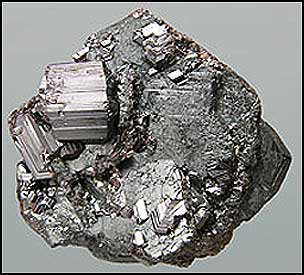
Mwinilunga, Zambia. Jordi Fabre specimen and photo.
Now it’s off to Norway, where some wonderful new amber-colored calcite specimens have emerged from a limestone mine already well known for fine calcites of other styles: the Dalen-Kjørholt mine, Kjørholt, Brevik, Porsgrunn, Telemark, Norway. The new specimens, taken out of two huge pockets in mid-2007, are clusters of lustrous, translucent to transparent calcite crystals to 9 cm long, in colors grading from pale brown to medium yellow-orange to rich amber. There are several generations of calcite growth, and specimens vary from simple, spiky clusters of scalenohedrons to subparallel groups which make stalactiform shapes. The specimens, a minority of them with crystals on gray limestone matrix, reach cabinet size, and can be seen, together with an account of the discovery, on the MinVision website (www.minvision.com). Calcite-occurrence adepts will associate the Dalen-Kjørholt mine mostly with smoky-translucent, greenish gray, hexagonal-prismatic crystals with low rhombohedral terminal faces, commonly displaying phantoms outlined by microcrystals of pyrite: such specimens, which began hitting the market in the early 1990’s, are quite pretty, but arguably not as pretty as these new pieces (see picture here).
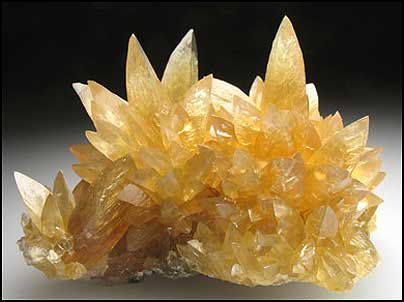
Telemark, Norway. MinVision specimen and photo.
Probably some mineral people are getting happily jaded with seeing ever-more-spectacular aquamarine beryl specimens from Pakistan, but much rarer and less well known are the smaller but likewise beautifully gemmy aquamarines from a site near Taplejung, on Mount Kachenjunga near the eastern edge of Nepal. These crystals differ from Pakistani ones in that they are generally not as sharp-edged but sport a much deeper blue color. On the web at present, Andrei Rykoff of AA Rockshop (www.aarockshop.com) is showing off small-miniature-size aquamarine matrix specimens from Taplejung, with gemmy, rich medium-blue terminated crystals to 4 cm lightly attached to matrix of white albite crystals and very sharp hexagonal muscovite plates. Exotic and “different” Nepalese aquamarine seems set to make its own reputation, if pieces as good as these continue to trickle out (Andrei only has six right now, from what he says is a “new find”).
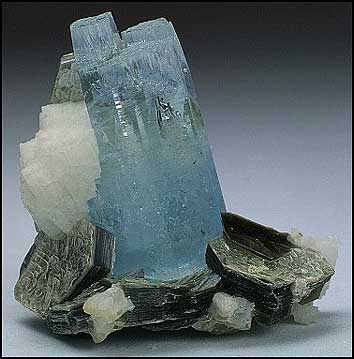
Andrei Rykoff specimen and photo.
At the stand of a small dealership in Munich last fall I noticed in passing a good selection of some bright new galena specimens from an unfamiliar (to me) locality in Germany—but the potential show-note was lost, for I couldn’t stop at the time and later forgot to check back (you know how this sort of thing goes at giant mineral shows). But now, to the rescue—the Web! A dealership called Cavnic Minerals is offering on its site (http://cavnicminerals.googlepages.com/index.htm) some miniature and small-cabinet-size clusters of sharp, highly lustrous, octahedral and cuboctahedral galena crystals to 2 cm individually. Responding to my e-mail, some people at Cavnic Minerals explain that 2,000 to 3,000 galena specimens of varying quality were collected between February and June 2007. They were recovered from a single enormous pocket under the “ground floor” of the Meyer quarry, near the village of Eschweiler, 15 km east of the old Carolingian capital city of Aachen, in Nordrhein-Westfalen. The best of the specimens are rounded clusters of sharp, brilliant galena crystals, as well as beautiful crystal-covered plates to 15 cm across. Some of the clusters came out covered with crusts of brown smithsonite, and small, mediocre pyrite and calcite crystals are sometimes present, but basically these are pure and simple examples of well crystallized galena, in pieces rivaling those from almost anywhere. (German-classics fans will think of the galena from Freiberg, Neudorf, or the Siegerland; it’s nice to see handsome specimens from a German locale that is different and distant from these, and contemporary at that).
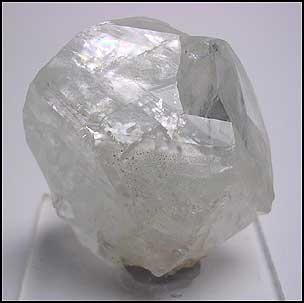
Felix Garcia Garcia specimen and photo.
A locality called Weisser Fluh (“white rock face”) in the famous Binn Valley of Canton Wallis (French: Valais), Switzerland has lately yielded some very nice clusters of twinned, colorless, milky-translucent to transparent, rhombohedral crystals of dolomite which are superb examples of the “Alpine” dolomite habit. Alpine-minerals specialist Felix Garcia Garcia of Edelweiss Minerals (www.edelweissminerals.com) is offering several loose groups of complexly interpenetrating dolomite crystals in groups from large-thumbnail to small-miniature size. They resemble the pristinely icy dolomite specimens which came a few years ago from the magnesite mine at Mt. Brussilof, British Columbia.
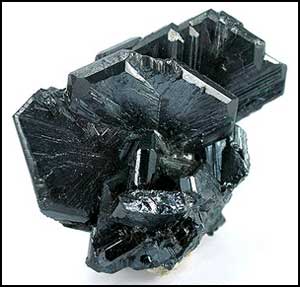
Rob Lavinsky specimen and photo.
Superbly well crystallized chalcocite from Australia is turning out to be a more complex topic than you might expect. In 2001 an Australian dealer made a major splash at the Tucson Show by offering a small number of amazing chalcocites from the Telfer gold mine, Carnarvon, Western Australia (see the Tucson report in May-June 2001)—these are wonderful specimens showing lustrous metallic black cruciform chalcocite twins to 3 cm long. Next, also in 2001 but exclusively in Australia, fine chalcocite specimens from the Mount Elliott mine, Selwyn, Queensland, were marketed: unlike the Telfer mine specimens, these typically show subparallel crystal aggregates to several centimeters, not cruciform twins. Next, in 2004-2005 an Australian dealer acquired a small number of chalcocites which reportedly had been found on the 4785 level of the “Gunpowder mine,” north of the Mount Isa district in Queensland: crystals to 2 cm form groups to 5 cm, and the lot (again, sold exclusively in Australia) included some specimens showing cruciform twins. Next, the 2007 Tucson Show hosted a tiny handful of chalcocite specimens reportedly from the “Mammoth mine” north of Mount Isa: these exhibit very sharp, thin-tabular, pseudohexagonal chalcocite crystals to 1.25 cm blanketing matrix. And now Rob Lavinsky of Arkenstone (www.irocks.com) has taken in a shipment of world-class chalcocites from the Mammoth mine, together with the information that this mine has operated for at least 60 years, and the township (mining camp) servicing it is called Gunpowder. Aha! then the “Gunpowder” and “Mammoth mine” specimens are the same…and even a quick glance at one of them (see pictures here) confirms that they’re worth taking so much trouble to get straight about. Rob’s Mammoth mine chalcocite specimens range in size from thumbnail to 7 cm across, with sharp pseudohexagonal platy crystals to 2.5 cm. The smaller crystals are brilliantly metallic black, whereas larger, compound crystals such as are commonly seen coating matrix are slightly rough-surfaced, less lustrous, and tend to be stained faintly green. Rob says that he will be bringing more—perhaps even newer—Mammoth mine chalcocites to the upcoming 2008 Tucson Show.
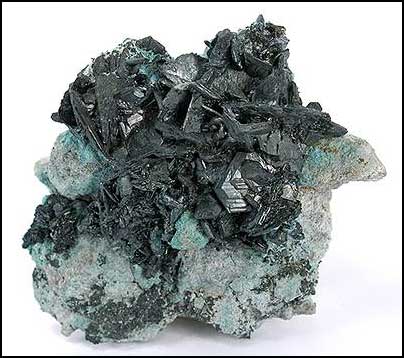
Australia. Rob Lavinsky specimen and photo.
A couple of interesting revisitations of older material come next. Andy Seibel (www.andyseibel.com) has some fine examples of the now-rare mimetite from somewhere in the Hat Yai district of Songkhla Province, Thailand which first surfaced on the market in 1998-1999. Andy says that the ten pieces now pictured on his site are not newly mined but rather come from an old stash, presumably one collected by the Italian prospectors who worked the locality just before the millennium’s turn. Some of Andy’s specimens show sharp, isolated, bright yellow hexagonal mimetite prisms or tabs to 1 cm attractively perched on dark brown gossan matrix; others show masses of mimetite crystals, more orange than yellow, in aggregates, either loose or on matrix. Available specimens range from 2.5 to 5.5 cm.
Mike Keim of the website-only Marin Mineral Company (www.marinmineral.com) is heartily to be commended for his December 2007 offerings of colorful “modern classics,” especially his rhodonites from the San Martín (formerly Chiurucu) mine, Peru (see the last Tucson Show report, May-June 2007); his anglesites from the fast-fading Touissit mine, Morocco; and his rhodochrosites from the Uchucchacua mine, Peru. But a small batch of “recently mined” little crystals of phosphophyllite from the Krause vein of the Unificada mine, Potosí, Bolivia must dominate the array, for what’s more guaranteed-interesting than Bolivian phosphophyllite? As Mike is quick to admit, these new crystals are not first-rate for the occurrence, being substantially etched and pale in color, and not every one is completely gemmy. But they are very pretty, intriguing just for being themselves, and not at all (for phosphophyllite) unreasonably priced. Mike has matrix specimens as well as loose crystals; the matrix pieces reach 3 cm across and the loner crystals reach 2.2 cm. The one specimen with a price in the low four figures (i.e. the most expensive one, still unsold as of January 8) is shown here: a gemmy 2-cm crystal for $1,500.
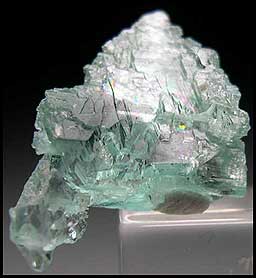
Potosí, Bolivia. Mike Keim specimen and photo.
I find the site of the young Kosnar brothers’ Mineral Classics impressive this time for its nine pages of Tsumeb specimens, plus one page of Berg Aukas specimens, lately acquired from the personal collection of Georg Gebhard, author of two magisterial texts, one German, one English, on the history and mineralogy of the great Tsumeb mine. Many of these specimens are dazzling, as you’d expect—recommending especially the many-hued smithsonites from Berg Aukas (much rarer than smithsonites from Tsumeb). Brian and Brett Kosnar have also recently done a deal to share with Arkenstone the marketing of a group of outstanding thumbnails from a small, high-end thumbnail collection recently relinquished onto the market. Some little killers are already up on the Arkenstone site, and more will surely accompany both Rob Lavinsky and the Kosnars to Tucson.
I seem to have developed a habit of ending each “On The Web” section with a glance at new minerals from China, quite often as seen on Mr. Chen Weigang’s www.china-mineral.cn: an on-the-spot site which is always well populated with newly found specimens and buzzing with business and novelty. This time Mr. Chen offers fine-looking specimens of several “new classics” we’ve come to recognize, e.g. stibnite from Nandan, Guangxi Autonomous Region; fluorite and other things (see this column’s previous installment) from the Shangbao mine, Hunan; and beautiful red sphalerite from the Shuikoushan mine, Hunan. From the Fengjiashan wollastonite mine, Daye distrtict, Hubei, already famous for its superb inesite, apophyllite, calcite, Japan-law-twinned quartz, etc. (see Berthold Ottens’ article in January-February 2007), Mr. Chen now has something new: goethite in metallic black to brown, acicular to bladed crystals reaching 4 cm long, in freestanding bundles and sprays on quartz and calcite crystal clusters. According to the accompanying text, the 20 or so goethite specimens, of small-miniature to small-cabinet size, came very recently from a single, so far unique pocket—and indeed goethite is not on Ottens’ list of well crystallized species from the Fengjiashan mine. A picture is not shown here, as those on the site are poor, but we should know henceforth to watch for more excellent goethite specimens from this locality.
The same “China II” issue of the Mineralogical Record (January-February 2007) that enlightens us on Fengjiashan also contains a short article by Wendell Wilson and Marcus Origlieri on the wulfenite which is now trickling out from (probably) somewhere in the Kuruktag Mountains, Xinjiang Uygur Autonomous Region, in far-northwestern China. This material, in highly varying quality, showed up spottily at all of the major shows in 2007, but it can get so fine, and the locality is so remote and supplies necessarily so chancy, that any sighting is news. Mr. Chen’s China-Mineral site has quite a few pieces (marked as being from “Xinjian”), and they look in general to be excellent, if never quite on a level with the very best which some top Western dealers have scored. The specimens range up to full cabinet-size, with very red tabular crystals in thick, rolling blankets on gossan matrix; individual crystals average 1 to 1.5 cm, and I think I can see a bit of a trend from red to orange coloration as crystal size increases.
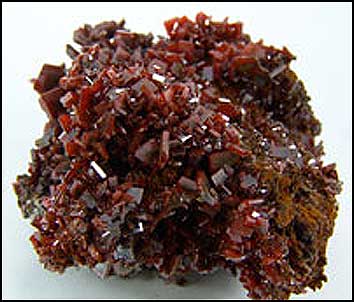
Autonomous Region, China. China-Minerals specimen and photo.
Concluding the market news, here’s a correction on a Chinese locality designation. In the 2007 Tucson Show report (May-June 2007) I passed on word that a place in China somewhere was turning out superb specimens showing colorless, transparent euclase crystals to 2 cm or so, in loose clusters and on matrix. In the last online “what’s new” column I showed a photo, contributed by Jürgen Tron, of a dramatically large Chinese euclase specimen; and in my report on the 2007 Denver Show (November-December 2007) I announced triumphantly, crediting Bert Ottens for the information, that the euclase hails from the Piaotang mine, Daye district, Hubei Province. Well…WRONG! Jürgen has written to point out that I mistook Bert’s communication by one critical letter: while “Piaotang mine” is correct, the district is Dayu, in Jiangxi Province, not Daye, in Hubei. A bit of browsing in Guanghua Liu’s Fine Minerals of China (2006) and in an atlas reveals that Dayu and Daye are about 500 kilometers apart, not to mention quite different mineralogically. Correct your labels, and pardon me for my dyslexic moment.
The New and the Changed…
The Internet Directory page in the March-April 2008 issue will list two new websites of special note, The Freilich Mineral Gallery (www.FreilichMinerals.com) and Joseph A. Freilich Bookseller (www.JosephAFreilichBookseller.com), respectively offering good minerals and good mineral-history books. Readers will recall that over a very short time in the 1990’s, New York diamond and jewelry entrepreneur Joe Freilich, with the cheerful help of Dave Wilber, built a superlative personal mineral collection, featured in our special January-February 2000 issue which presented a “photo album” of glorious Freilich Collection specimens. Although he auctioned off most of that collection a year later, these two new websites now make it clear that Joe is remaining a presence in the mineral world: the sites are aesthetically classy (as are quite a few of the minerals in the first one), and we wish their proprietor well in his new ventures.
Another interesting website not quite as new—it debuted a year ago, in January 2007—is that of Ralph Sutcliffe Minerals (www.ralphsutcliffeminerals.co.uk), with a diverse enough offering of specimens from the British Isles as to constitute an introductory short course in major localities in and around the UK. Besides five small galleries of worldwide specimens, and besides many artifacts, documents and “paraphernalia” related to British mining, Ralph has selections of classic specimens from (among others) Alston Moor and the Roughton Gill mine, Cumbria; several old familiar-sounding mines in Cornwall, Devon and Somerset; Leadhills and Wanlockhead, Scotland; the zeolite-bearing highlands and islands of Scotland; and even a few places in the Republic of Ireland. I show here an image from his well-stocked page on Cumbrian calcite, featuring many loose, smallish, pellucid “butterfly” twins. The calcites are all from the Pallaflat mine at Pallaflat, Egremont, Cumbria, which was prolific in such specimens in the 19th century but not in later times. Surely Ralph’s site will turn out to be worth regular visits.

Cumbria, England. Ralph Sutcliffe specimens and photo.
Two personal milestones now. First, well known mineralogist Dr. Pete J. Dunn of the Smithsonian Institution’s Department of Mineral Sciences has announced that he is soon to retire from professional life after decades of fruitful work, and more new mineral species descriptions to his credit than anyone else, past or present.
A much sadder note is the sudden death of dealer Ernesto Ossola in Morocco late last year. Jolly, always-enthusiastic Ernesto has been bringing Moroccan minerals, many of them self-collected, to shows for more than 20 years now; just last year at Tucson he was excited to have had with him a number of microcrystal specimens of super-rare species, some of them possibly new and as yet undescribed, from Bou Azzer. Ernesto’s family members and friends have the sympathy of the Mineralogical Record and, surely, of all of Ernesto’s old customers too.
And now I must begin to do many things, personal and professional, to get ready for the mammoth show coming soon to the town where I live, which is TUCSON, podner. The Mineralogical Record will maintain a table at the InnSuites show this year and, of course, at the “Main Show” in the Convention Center—and so, I suppose, I’ll see some of you web-visiting podners there.
For questions about this column, please email Tom Moore.
